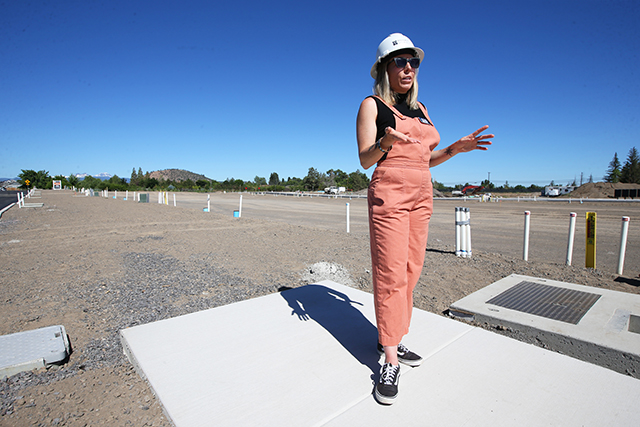Oregon will issue loans to help build middle-income homes
Published 12:05 pm Thursday, February 20, 2025
Oregon will soon begin issuing loans to help developers finance construction of middle-income housing, an increasingly common strategy in other states tackling the nation’s home affordability crisis.
State lawmakers approved $75 million last year to test a “Moderate Income Revolving Loan program” meant to help get new housing projects over the line.
Trending
A bevy of factors, including high interest rates, have tripped the state into a homebuilding slump. Oregon’s chief economist went before state lawmakers last month to stress that the state needs 29,500 units annually to meet the demands of an anticipated rebound in migration into Oregon. The economist, Carl Riccadonna, said Oregon permitted a little less than half that last year.
Money from the revolving loan fund will funnel through cities and counties as zero-interest loans and on to developers as grants, as they’re defined in statute. Developers must then rent or sell to households earning, at most, 120% of an area’s median income.
And instead of paying property taxes, the “grantees” will pay back the money as a fee to the local governments, which will in turn pay back the state. If everyone pays their debts, money will revolve through the fund and enable the state to issue more loans over time.
State housing-finance agency officials expect the $75 million to produce between 2,000 and 3,000 new homes, said Andrea Bell, director of Oregon Housing and Community Services.
How long that will take remains unclear, according to an agency spokesperson. OHCS based its estimate on spending $30,000 per unit, enough for 2,500 homes.
Asked why the loans were zero-interest, Bell said it was to make them “competitive,” “feasible” and “flexible.”
Trending
Government subsidies have typically gone toward housing where income restrictions are much more stringent. This is what’s referred to in housing circles as “capital A” affordable housing.
But across the U.S., state and local governments are experimenting with programs to juice the construction of middle-income homes, too.
The programs show some promise of expanding housing supply, particularly where affordability issues are most acute or where development is most difficult, according to researchers with the Joint Center for Housing Studies of Harvard University.
However, Harvard researchers wrote in a working paper last year, the middle-income subsidy programs “face backlash from housing advocates who fear these subsidies will redirect resources away from lower-income households with the greatest need.” As such, middle-income programs shouldn’t replace or detract from programs for low-income households, researchers argued.
In an interview, Bell said that while Oregon has traditionally focused on housing for those at the lower end of the income spectrum, “our responsibility, frankly, is to also expand the tools and resources based on the realities of everyday folks.”
“We heard, and certainly have understood, the need for more options for middle-income housing,” Bell said, “and so this is one of the ways in which we’re aiming to do more of that.”
In Oregon, one of the state’s main avenues to fund low-income housing is the Local Innovation and Fast Track program. Lawmakers put $600 million into that program in the current budget cycle, and Gov. Tina Kotek wants them to allocate another $800 million this session, including for rentals and for-sale homes.
But in a show that the moderate-income program is in its test phase, Kotek is not asking for more money for that program yet. Still, the governor lauded the program’s launch on Thursday.
“This program is an essential piece of the affordability puzzle, lending a hand to our local partners who need a little help to make the balance sheet make sense,” Kotek said in a statement.
The bulk of the state’s housing investments will still likely need to go toward deeply affordable housing, said state Rep. Pam Marsh, D-Ashland, chair of the House Committee on Housing and Homelessness.
But if Oregon doesn’t invest anything in middle-income housing, Marsh told The Oregonian/OregonLive, the state won’t experience the “filtering” — an economics concept that holds houses open to families of different incomes as the properties age — that occurs when developers build homes for residents of many incomes.
In other words, she said, homes won’t have a healthy “churn” among residents as families climb up the income ladder and move to more expensive homes.
In a statement, state Sen. Dick Andersen, R-Lincoln City, vice chair of the Senate Committee on Housing and Development, said the loans are an innovation that will “help with the cost of housing projects.”
Proponents of middle-income programs say they can fund new construction with lower subsidies than deeply affordable housing. For example, OHCS estimates a $700 million proposed investment in LIFT this year to translate to 7,000 rentals — a public subsidy of $100,000 per apartment.
That doesn’t count the myriad other funding sources that come together to comprise what’s called a capital stack: the layers, sometimes more than a dozen, that developers must arrange to make their projects financially viable.
While middle-income construction subsidies reached up to $100,000 per unit in affluent Massachusetts, that figure represents the “high end,” and subsidies are “generally modest” in many states, the Harvard researchers reported.
They calculated the cost of one Georgia program that focused on infrastructure as a way to spur moderate-income housing at about $23,000 per unit. A Kansas program doled out roughly $27,000 per unit, the Harvard working paper noted.
Bell said she doesn’t view affordable and middle-income housing programs as mutually exclusive.
She said: “We have to come from a place of abundance and opportunity.”








